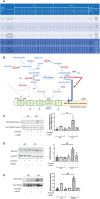Metabolic Bypass Rescues Aberrant S-nitrosylation-Induced TCA Cycle Inhibition and Synapse Loss in Alzheimer's Disease Human Neurons
- PMID: 38235614
- PMCID: PMC10966553
- DOI: 10.1002/advs.202306469
Metabolic Bypass Rescues Aberrant S-nitrosylation-Induced TCA Cycle Inhibition and Synapse Loss in Alzheimer's Disease Human Neurons
Abstract
In Alzheimer's disease (AD), dysfunctional mitochondrial metabolism is associated with synaptic loss, the major pathological correlate of cognitive decline. Mechanistic insight for this relationship, however, is still lacking. Here, comparing isogenic wild-type and AD mutant human induced pluripotent stem cell (hiPSC)-derived cerebrocortical neurons (hiN), evidence is found for compromised mitochondrial energy in AD using the Seahorse platform to analyze glycolysis and oxidative phosphorylation (OXPHOS). Isotope-labeled metabolic flux experiments revealed a major block in activity in the tricarboxylic acid (TCA) cycle at the α-ketoglutarate dehydrogenase (αKGDH)/succinyl coenzyme-A synthetase step, metabolizing α-ketoglutarate to succinate. Associated with this block, aberrant protein S-nitrosylation of αKGDH subunits inhibited their enzyme function. This aberrant S-nitrosylation is documented not only in AD-hiN but also in postmortem human AD brains versus controls, as assessed by two separate unbiased mass spectrometry platforms using both SNOTRAP identification of S-nitrosothiols and chemoselective-enrichment of S-nitrosoproteins. Treatment with dimethyl succinate, a cell-permeable derivative of a TCA substrate downstream to the block, resulted in partial rescue of mitochondrial bioenergetic function as well as reversal of synapse loss in AD-hiN. These findings have therapeutic implications that rescue of mitochondrial energy metabolism can ameliorate synaptic loss in hiPSC-based models of AD.
Keywords: Alzheimer's diseases; S‐nitrosylation; tricarboxylic acid cycles.
© 2024 The Authors. Advanced Science published by Wiley‐VCH GmbH.
Conflict of interest statement
The authors declare no conflict of interest.
Figures




References
-
- Wu Y. H., Hsieh H. L., Antioxidants 2023, 12, 1816. - PubMed
-
- Venkataraman A. V., Mansur A., Rizzo G., Bishop C., Lewis Y., Kocagoncu E., Lingford‐Hughes A., Huiban M., Passchier J., Rowe J. B., Tsukada H., Brooks D. J., Martarello L., Comley R. A., Chen L., Schwarz A. J., Hargreaves R., Gunn R. N., Rabiner E. A., Matthews P. M., Sci Transl Med 2022, 14, eabk1051. - PubMed
-
- Dekosky S. T., Scheff S. W., Ann. Neurol. 1990, 27, 457. - PubMed
MeSH terms
Grants and funding
- R01 AG061845/NH/NIH HHS/United States
- R01 AG061845/AG/NIA NIH HHS/United States
- RF1 NS123298/NH/NIH HHS/United States
- R01 DA048882/NH/NIH HHS/United States
- R35 AG071734/AG/NIA NIH HHS/United States
- R01 AG078756/AG/NIA NIH HHS/United States
- P30 AG062429/AG/NIA NIH HHS/United States
- R01 AG056259/NH/NIH HHS/United States
- RF1 NS123298/NS/NINDS NIH HHS/United States
- R61 NS122098/NH/NIH HHS/United States
- DP1 DA041722/NH/NIH HHS/United States
- R56 AG065372/NH/NIH HHS/United States
- R56 AG065372/AG/NIA NIH HHS/United States
- R61 NS122098/NS/NINDS NIH HHS/United States
- R01 AG056259/AG/NIA NIH HHS/United States
- R01 NS123298/NS/NINDS NIH HHS/United States
- R01 DA048882/DA/NIDA NIH HHS/United States
- RF1 AG057409/AG/NIA NIH HHS/United States
- DP1 DA041722/DA/NIDA NIH HHS/United States
- RF1 AG057409/NH/NIH HHS/United States
- R35 AG071734/NH/NIH HHS/United States
- U01 AG088679/AG/NIA NIH HHS/United States
LinkOut - more resources
Full Text Sources
Medical
Molecular Biology Databases
